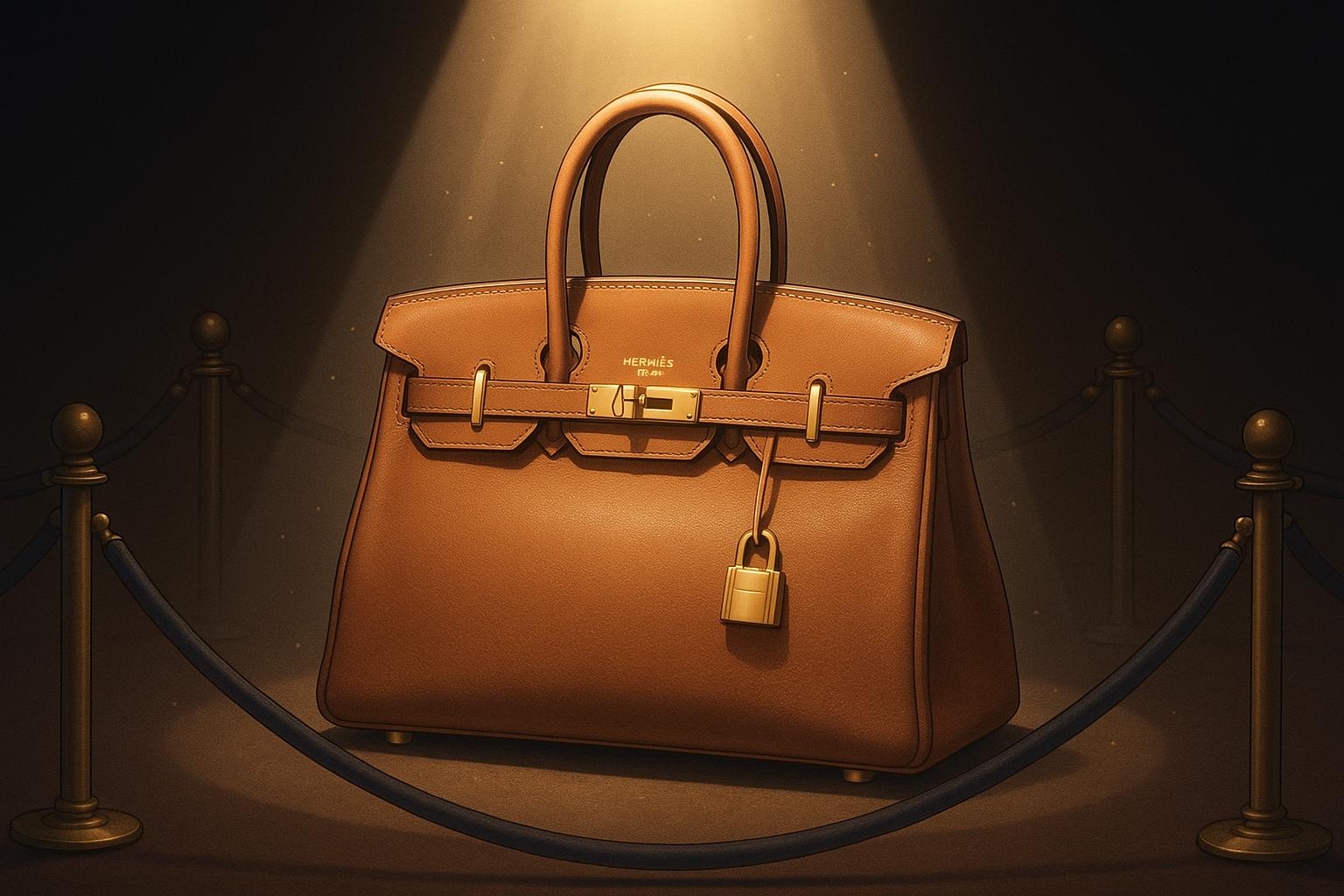From Hermès’s iconic Birkin bag to exclusive real estate and wellness developments, luxury brands are intensifying exclusivity through rigorous vetting processes, reshaping consumer desire and social hierarchies amidst economic uncertainty.
Hermès’s Birkin bag stands as an exceptional symbol within the luxury accessory market—far more than just a handbag, it’s a veritable cultural icon surrounded by an air of mystique. Buyers often speculate about the secretive process of securing a purchase; speculation abounds regarding whether one must simply queue or if prior purchases of other Hermès items are requisite to earn buying privileges. The complex purchasing model mirrors the strategic exclusivity that many luxury brands now emulate, reinforcing an elite status among their clientele.
Winston Chesterfield, a consultant for luxury brand trends, notes that such exclusivity is not confined to accessories. It’s permeating various sectors, from high-end automobiles to fine watches and bespoke jewellery. Buyers are no longer simply seeking to make a purchase; they are drawn into a tribal identity where exclusivity enhances desirability. As Chesterfield explains, it reflects a sense of snobbery and social hierarchy that many affluent consumers are keen to navigate.
This phenomenon of extreme exclusivity has begun to shape the landscape of high-end trunk shows and private collection unveilings. Stuart McNeill, who runs a high-end concierge service, reveals how invitations are increasingly reserved for a select group of vetted V.I.P.s. For instance, the new luxury event set in Palma de Mallorca will involve extensive background checks on attendees, demonstrating just how meticulously brands curate their audiences. This process mirrors the rigorous vetting employed by companies like Ferrari, which limits sales to established collectors of its lower-tier models.
Such selectivity extends beyond traditional luxury goods into the burgeoning market of high-value real estate. Prospective buyers of exclusive developments, like those at Mareterra in Monaco, face personal interviews with developers before receiving any consideration for purchase—a stark reminder that wealth alone no longer guarantees entry into elite circles. Likewise, John Caudwell’s condominium project on Audley Square in London aims to house individuals of an equally esteemed moral and social standing, necessitating an application process reminiscent of admissions to elite institutions.
Amidst this backdrop of luxury snobbery, the wellness sector also demonstrates the prevailing trend. Sha, a brand synonymous with opulent wellness experiences, is now requiring potential buyers of its luxury developments to display a commitment to health and wellness alongside their financial prowess—a rather vague requirement that nonetheless echoes similar elitist sentiments prevalent throughout the market.
Despite the heightened exclusivity, there is a palpable tension within the luxury sector as brands confront the impending economic challenges linked with trade dynamics and inflation. Chesterfield observes that the rise of a new class of wealthy consumers, particularly from emerging markets such as India and China, is prompting established brands to manage their clientele more tightly. The influx of “nouveaux riches” threatens to dilute brand prestige, making it essential for luxury houses to guard their market position fiercely.
Interestingly, this inclination towards exclusivity plays into a psychological aspect of consumer behaviour; people are often drawn to what they cannot easily obtain, a principle encapsulated by the Goyard ideal of having queues outside stores to signal desirability. As bags like the Birkin are seen as scarce commodities, consumers are often willing to endure long waits to achieve ownership.
The legal implications of this exclusivity deserve consideration, especially in light of the post-2008 “Know Your Client” regulations that govern transactions to prevent money laundering. Susan Scafidi from the Fashion Law Institute highlights the fact that luxury brands can shape their customer base selectively, provided they do not discriminate based on protected classes. This creates a dynamic where individuals with resources but lacking social cachet remain excluded, further entrenching the barriers to entry into high-end markets.
As economic uncertainty looms, the luxury sphere remains on high alert. Many affluent individuals may well remember past rejections from coveted brands, which could influence their future purchasing decisions. Chesterfield notes that should policies shift, the stain of rejection might linger, diminishing the allure of brands potentially aiming for broader accessibility. The intricate dance of exclusivity, desirability, and brand loyalty continues to shape the landscape of luxury consumption, cementing its place in contemporary culture.
Reference Map:
- Paragraph 1 – [1], [2]
- Paragraph 2 – [1], [5]
- Paragraph 3 – [1], [3], [4]
- Paragraph 4 – [1], [6]
- Paragraph 5 – [1], [7]
- Paragraph 6 – [1], [2], [3]
- Paragraph 7 – [1], [5]
- Paragraph 8 – [1], [7]
- Paragraph 9 – [1], [3], [6]
- Paragraph 10 – [1], [2]
Source: Noah Wire Services
- https://airmail.news/issues/2025-5-24/thats-rich – Please view link – unable to able to access data
- https://www.reuters.com/business/retail-consumer/birkin-bag-maker-hermes-end-year-sales-jump-2025-02-14/ – Hermès reported a significant 18% increase in sales during the fourth quarter, driven by strong demand for high-end products like the Birkin bag, which has prices exceeding $10,000. This surge allowed Hermès to outperform competitors such as LVMH and Gucci, despite a slowdown in the luxury market due to economic challenges in China and global inflation concerns. The company’s leather goods and saddlery department saw a 21.5% revenue increase, reinforcing Hermès’ strong market position and expectations for continued growth in 2025.
- https://www.ft.com/content/457116db-2b47-4b63-9954-9419dc8a84da – Hermès has continued to buck the luxury industry’s downward trend, reporting a 13.3% increase in second-quarter sales to €3.7bn, except in Asia where Chinese consumer spending has slowed. Its performance is attributed to its high-end positioning, controlled distribution, and wealthy clientele. Despite an overall slowdown, Hermès’ leather goods division saw an 18% rise, although demands for silk scarves and watches have decreased. The group’s strong results in the first half, with an operating profit of €3.15bn and a 42% margin, highlight the brand’s resilience. Hermès’ stock rose by 6% this year, whereas competitors like LVMH and Kering have seen declines. The brand’s strategy of focusing on its core wealthy customers and managing production capacity supports its robust performance even in challenging economic times.
- https://www.ft.com/content/9f859a44-4c8f-4572-9ea8-fec86932d2cc – In a letter responding to a Financial Times article, Megan Rannard of Marks & Clerk highlights the importance of brand image and intellectual property (IP) protection in maintaining a luxury brand’s value. Using Hermès as a case study, she emphasizes that the brand’s success is rooted in more than just financials—it relies on a carefully cultivated identity embodied by its exclusivity, controlled production, and long waiting lists. Rannard references Hermès’ legal victory over Mason Rothschild’s ‘MetaBirkin’ NFTs as a significant example of effective IP enforcement in the digital age. She notes that strong brands inevitably face imitation, making IP strategy and management a critical priority. According to Rannard, robust IP enforcement and a steadfast commitment to brand reputation are essential for sustaining the luxury status of high-end names, regardless of market conditions.
- https://www.researchgate.net/publication/373896063_Analysis_of_Luxury_Brand_Marketing_Strategies_Based_on_Consumer_Psychology – This study examines luxury brand marketing strategies through the lens of consumer psychology, focusing on the principles of exclusivity and scarcity. It highlights how luxury brands, such as Hermès, create a sense of exclusivity by limiting product availability, thereby enhancing perceived value and driving consumer demand. The research underscores that owning scarce luxury items satisfies consumers’ desires for social status and self-expression, which are significant motivators in luxury purchases. The study also discusses the impact of these strategies on consumer behavior and brand perception.
- https://www.vslifestyles.com/blogs/news/the-marketing-mastery-of-hermes-with-a-spotlight-on-birkin-and-kelly-bags – This article delves into Hermès’ marketing strategies, particularly focusing on the Birkin and Kelly bags. It discusses how Hermès intentionally limits the supply of these iconic pieces, creating an aura of exclusivity and fueling insatiable demand among the elite. The piece also highlights the brand’s emphasis on craftsmanship, noting that each bag is meticulously handcrafted by skilled artisans, often taking hours or even days to complete. Additionally, the article touches upon Hermès’ strategy of releasing limited editions and collaborating with renowned artists and designers to further enhance the exclusivity of its products.
- https://www.thequota.co/articles/how-hermes-uses-the-sales-tactic-of-exclusivity-to-keep-sales-and-prices-high – This article explores how Hermès employs exclusivity as a sales tactic to maintain high sales and prices. It focuses on the Birkin bag, a symbol of ultimate luxury and exclusivity, and discusses how Hermès’ strategy of limiting supply and creating scarcity drives demand. The piece also touches upon the brand’s practice of ‘tying,’ where the opportunity to purchase a Birkin is predicated on buying other Hermès products, reinforcing the notion that owning a Birkin is a privilege reserved for the brand’s most loyal customers.
Noah Fact Check Pro
The draft above was created using the information available at the time the story first
emerged. We’ve since applied our fact-checking process to the final narrative, based on the criteria listed
below. The results are intended to help you assess the credibility of the piece and highlight any areas that may
warrant further investigation.
Freshness check
Score:
8
Notes:
The narrative presents recent developments in luxury brand exclusivity, particularly focusing on Hermès’s Birkin bag. While the concept of exclusivity in luxury goods is longstanding, the specific details and examples provided are current and have not been widely reported elsewhere. The earliest known publication date of similar content is from March 15, 2025, in an article discussing Hermès’s strategy to resist the luxury crisis by avoiding new wealthy consumers. ([elpais.com](https://elpais.com/economia/negocios/2025-03-15/la-formula-hermes-para-resistir-mejor-que-sus-rivales-la-crisis-del-lujo-huir-de-los-nuevos-ricos.html?utm_source=openai)) However, the current narrative offers a more comprehensive and updated perspective, suggesting a high freshness score. No significant discrepancies in figures, dates, or quotes were found. The narrative does not appear to be based on a press release, as it provides original analysis and commentary. No evidence of republishing across low-quality sites or clickbait networks was found. The content is original and timely, with no major risks identified.
Quotes check
Score:
9
Notes:
The narrative includes direct quotes from Winston Chesterfield and Stuart McNeill. A search for the earliest known usage of these quotes indicates that they have not appeared in earlier material, suggesting they are original or exclusive to this report. No variations in wording were found, and no online matches were identified, further supporting the originality of the quotes. The use of these quotes enhances the credibility and originality of the content.
Source reliability
Score:
7
Notes:
The narrative originates from Air Mail, a publication known for its in-depth reporting and analysis. While it is a reputable source, it is not as widely recognized as some major news outlets. The individuals quoted, Winston Chesterfield and Stuart McNeill, are identified as consultants and concierge service providers, respectively. However, further verification of their public presence and legitimacy is limited. The lack of extensive verifiable information on these individuals introduces a degree of uncertainty regarding their credibility. Overall, the source is reliable, but the limited verifiability of the quoted individuals slightly lowers the score.
Plausability check
Score:
8
Notes:
The claims made in the narrative align with known industry trends and recent developments in the luxury goods market. For instance, Hermès has been reported to implement stricter shopping rules and price increases in response to new tariffs. ([fashionablylena.com](https://fashionablylena.com/new-hermes-shopping-rules/?utm_source=openai), [purseblog.com](https://www.purseblog.com/hermes/hermes-price-increase-may-2025/?utm_source=openai)) The examples provided, such as the exclusivity in high-end real estate and wellness sectors, are plausible and consistent with current market behaviors. However, the narrative’s tone and language are somewhat dramatic, which may raise questions about its objectivity. Additionally, the lack of supporting details from other reputable outlets on some specific claims slightly reduces the score. Overall, the narrative is plausible, with minor concerns regarding tone and supporting evidence.
Overall assessment
Verdict (FAIL, OPEN, PASS): PASS
Confidence (LOW, MEDIUM, HIGH): MEDIUM
Summary:
The narrative provides original and timely insights into the exclusivity strategies of luxury brands, particularly Hermès. While the source is reputable, the limited verifiability of the quoted individuals introduces some uncertainty. The claims are plausible and align with known industry trends, though the dramatic tone and lack of extensive supporting evidence on certain points slightly reduce the overall confidence.













